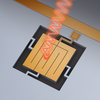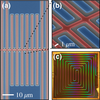The Quantum Sensors Division develops advanced photon and particle sensors to measure energy and power more precisely than traditional technologies. The sensors make use of (1) quantum effects, especially superconductivity, to provide high responsivity and (2) ultra-low temperatures to suppress noise. Signals of interest span the electromagnetic spectrum from millimeter-waves produced in the earliest moments of the universe to gamma-rays produced by nuclear fuel.
The Quantum Sensors Division applies advanced sensors to challenging measurement problems in a wide range of fields. The work often involves collaboration with companies and research institutes outside of NIST. Devices fabricated by the Division have been used in places that include outer space, the South Pole, the Atacama Plateau, the summit of Mauna Kea, nuclear laboratories, quantum computers, particle accelerators and synchrotrons.
The Quantum Sensors Division has existed in various forms since its creation in the early 1990s. Over this span of time, the Division has grown to more than 50 scientists, technicians, engineers, and students. Members of the Division have done pioneering research on topics that include superconducting transition-edge sensors, SQUID multiplexing, parametric amplifiers, microwave kinetic inductance detectors, and several types of advanced refrigerators.
The Quantum Sensors Division is presently divided into 4 groups:
- Device Fabrication
- Long Wavelength Sensors and Applications
- Quantum Calorimeters
- Quantum Electronics
Major activities of the Quantum Sensors Division include:
- superconducting x-ray and gamma-ray spectrometers for applications that include materials analysis and nuclear materials accounting
- superconducting microbolometers for applications that include understanding the early universe and concealed weapons detection
- advanced cryogenics to aid the dissemination of quantum electronics
- the determination of atomic and nuclear reference data to facilitate materials analysis
- support of U.S. industries that develop or use cryogenics, quantum sensors, and quantum computing
Some current projects include the Athena x-ray satellite, Simons Observatory, and CMB-S4. Please see the NIST Measuring the Cosmos page for more details.
News and Updates
Projects and Programs
Awards
Press Coverage
Patents
- Microwave Polarimetry: Precision Measurements for Cosmological Physics
- Superconducting Detectors for Photons from Millimeter Waves through Gamma Rays
- High Performance Cryogenics
- X-Ray Science with Superconducting Sensors
- Microwave Polarimetry: Precision Measurements for Cosmological Physics
- Superconducting Quantum Interference Device Development
Contacts
Division Chief and Deputy Division Chief
-
(303) 497-4408
-
(303) 497-4463













